- Growing Schefflera Plants: Care Tips and Tricks
- Choose the right location
- Provide the right temperature
- Watering
- Fertilizing
- Pruning
- Propagation
- Pests
- Common Varieties
- Tips and Tricks
- The Beautiful and Diverse Schefflera Species Varieties
- 1. Schefflera actinophylla (Australian Umbrella Tree)
- 2. Schefflera arboricola (Dwarf Umbrella Tree)
- 3. Schefflera delavayi (Delavay’s Umbrella Tree)
- 4. Schefflera elegantissima (False Aralia)
- 5. Schefflera taiwaniana (Taiwan Schefflera)
- 6. Schefflera pueckleri (Umbrella Tree)
- How to Propagate Schefflera: Step-by-Step Guide
- Step 1: Gather the Necessary Materials
- Step 2: Choose the Method of Propagation
- Step 3: Take Stem Cuttings
- Step 4: Care for the New Plants
- Step 5: Enjoy Your Propagated Schefflera Plants
- Common Pests and Diseases that Affect Schefflera Plants
- Pests
- Diseases
- Indoor vs Outdoor: Best Growing Conditions for Schefflera
- Indoor Growing Conditions
- Outdoor Growing Conditions
- Stunning Photos of Schefflera Plants in Different Settings
- The Fascinating History and Origins of Schefflera
- Discovery and Introduction to Gardening
- Symbolism and Cultural Significance
- Adapting to Different Environments
- Species and Varieties
- Troubleshooting Common Issues in Schefflera Care
- 1. Yellowing leaves
- 2. Drooping leaves
- 3. Leaf spots
- 4. Root rot
- 5. Pest infestation
- 6. Leaf drop
- 7. Slow growth
- 8. Wilting
- Q&A:
- What is schefflera?
- What are the different species of schefflera?
- How do I care for schefflera plants?
- What are some common problems with schefflera plants?
- Can schefflera be propagated?
- Video: Umbrella Plant Care | Schefflera Care | Tips N Tricks | Indoor Gardening | Bubbles of Green
Schefflera, also known as umbrella plant, is a popular houseplant with its distinctive umbrella-shaped leaves that give it a unique appearance. This versatile plant is native to tropical regions and can be found in various species and varieties.
When it comes to caring for schefflera, it is important to provide it with the right conditions to thrive. This includes placing it in a well-lit area, but away from direct sunlight, as too much sun can cause the leaves to burn. Schefflera also prefers a warm and humid environment, so misting the leaves regularly can help mimic its natural habitat.
Watering schefflera properly is essential for its health. It is important to keep the soil consistently moist, but not wet. Overwatering can lead to root rot, so it is best to let the top inch of soil dry out before watering again. Adding a layer of mulch can help retain moisture in the soil.
Schefflera comes in different species and varieties, each with its own unique characteristics. Some popular species include Schefflera arboricola and Schefflera actinophylla. The arboricola variety is dwarf and compact, making it ideal for small spaces, while the actinophylla variety can grow up to 8 feet tall and is known for its large, glossy leaves.
Overall, schefflera is a beautiful and easy-to-care-for houseplant that can add a touch of tropical elegance to any indoor space. With proper care and attention, schefflera can thrive and become a stunning focal point in your home.
“I love how schefflera adds a touch of greenery and tropical vibes to my living room. It is such an easy plant to care for and the umbrella-shaped leaves are simply stunning.” – Plant enthusiast
Growing Schefflera Plants: Care Tips and Tricks
Choose the right location
Schefflera plants thrive best in bright, indirect light. Place them near a window with filtered sunlight. Avoid direct sunlight, as it can burn the leaves.
Provide the right temperature
Schefflera plants prefer temperatures between 65-85°F (18-29°C). Avoid exposing them to temperatures below 55°F (13°C) as it can cause damage to the plant.
Watering
Water the plant when the top inch of soil feels dry to the touch. Avoid overwatering, as it can lead to root rot. Ensure proper drainage by using a well-draining potting mix and a pot with drainage holes.
Fertilizing
Feed Schefflera plants with a balanced liquid fertilizer once a month during the growing season (spring and summer). Follow the instructions on the fertilizer package for the proper dosage.
Pruning

Prune Schefflera plants to maintain their shape and remove any dead or yellowing leaves. Use clean, sharp pruning shears and make cuts just above a leaf node. Trim back leggy stems to encourage bushier growth.
Propagation
Schefflera plants can be propagated from stem cuttings or air layering. Cut a 4-6 inch stem with at least 2-3 leaf nodes and remove the bottom leaves. Plant the cutting in a well-draining potting mix and keep it moist until roots develop.
Pests
Watch out for common pests such as aphids, mealybugs, and spider mites. Inspect the plant regularly and treat any infestations promptly with organic insecticidal soap or neem oil.
Common Varieties
- Schefflera arboricola (Dwarf umbrella tree)
- Schefflera actinophylla (Umbrella tree)
Tips and Tricks
- Rotate the plant periodically to ensure even growth.
- Mist the leaves occasionally to increase humidity.
- Monitor the soil moisture regularly to prevent waterlogging.
- Consider using a pebble tray or humidifier to increase humidity.
| Light | Water | Temperature | Fertilizer |
|---|---|---|---|
| Bright, indirect light | Allow top inch of soil to dry before watering | 65-85°F (18-29°C) | Monthly during growing season |
The Beautiful and Diverse Schefflera Species Varieties
Schefflera, also known as the umbrella tree, is a popular houseplant with a wide variety of species and cultivars. Each variety has its own unique characteristics and requirements, making it an exciting plant to collect and care for.
1. Schefflera actinophylla (Australian Umbrella Tree)
This species is native to Australia and is characterized by its large, glossy, palmate leaves that resemble the shape of an umbrella. It is a fast-growing plant that can reach heights of up to 10 feet. It is commonly used as an ornamental plant in tropical and subtropical regions.
2. Schefflera arboricola (Dwarf Umbrella Tree)
This compact variety is native to Taiwan and is popular for its smaller size and attractive foliage. It has smaller, oval-shaped leaves that are typically green, but variegated cultivars with cream or yellow markings are also available. It is a great choice for indoor cultivation as it can tolerate lower light conditions.
3. Schefflera delavayi (Delavay’s Umbrella Tree)
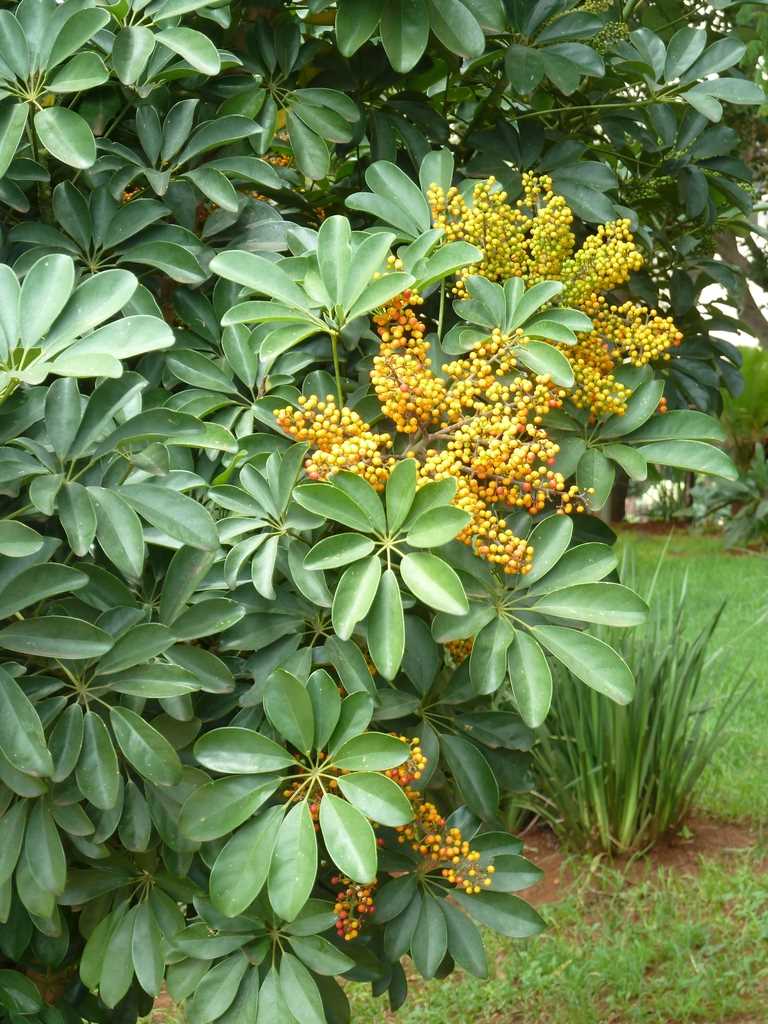
This species is native to China and is known for its large, glossy leaves that are divided into multiple leaflets. It has a more upright growth habit compared to other Schefflera varieties. It can grow up to 6 feet tall and is best suited for outdoor cultivation in warm climates.
4. Schefflera elegantissima (False Aralia)
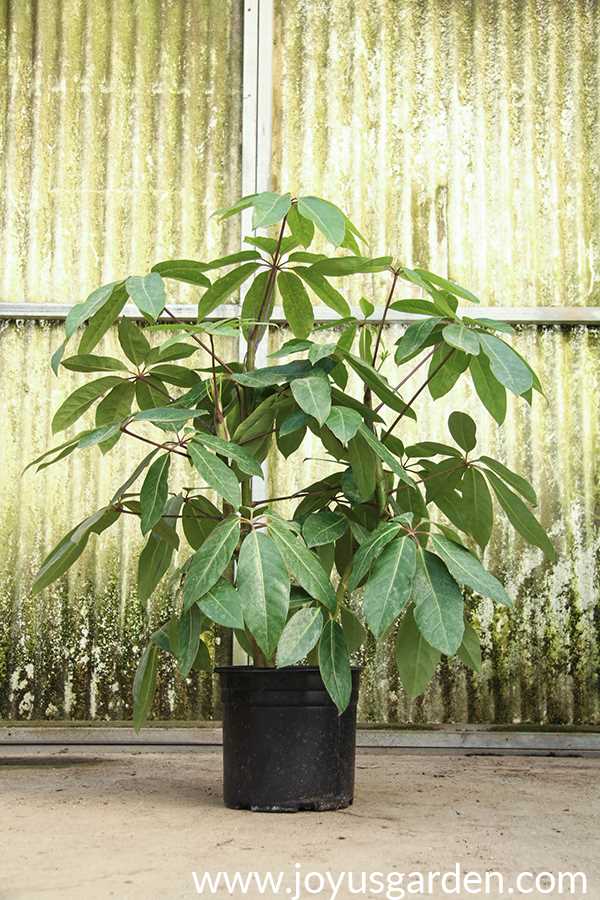
This variety is native to New Caledonia and is prized for its attractive foliage. It has long, narrow leaves with serrated edges that are green in color, with white or silver markings. It is a slow-growing plant that prefers bright, indirect light and high humidity.
5. Schefflera taiwaniana (Taiwan Schefflera)
This species is endemic to Taiwan and is known for its large, round leaves that are deeply lobed. It has a compact growth habit and is often used as a bonsai plant. It thrives in bright, indirect light and high humidity.
6. Schefflera pueckleri (Umbrella Tree)
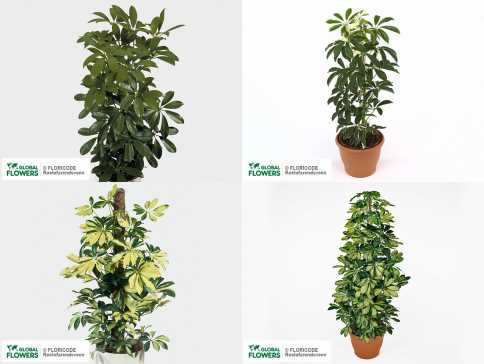
This species is native to Southern Mexico and Central America and is characterized by its large, palmate leaves that can reach up to 3 feet in diameter. It is a fast-growing plant that requires ample space to grow. It prefers bright, indirect light and frequent watering.
These are just a few examples of the many Schefflera species and cultivars available. Each variety brings its own unique beauty and charm to any indoor or outdoor space. Whether you’re a beginner or an experienced plant enthusiast, there’s a Schefflera variety that will suit your needs and preferences.
How to Propagate Schefflera: Step-by-Step Guide
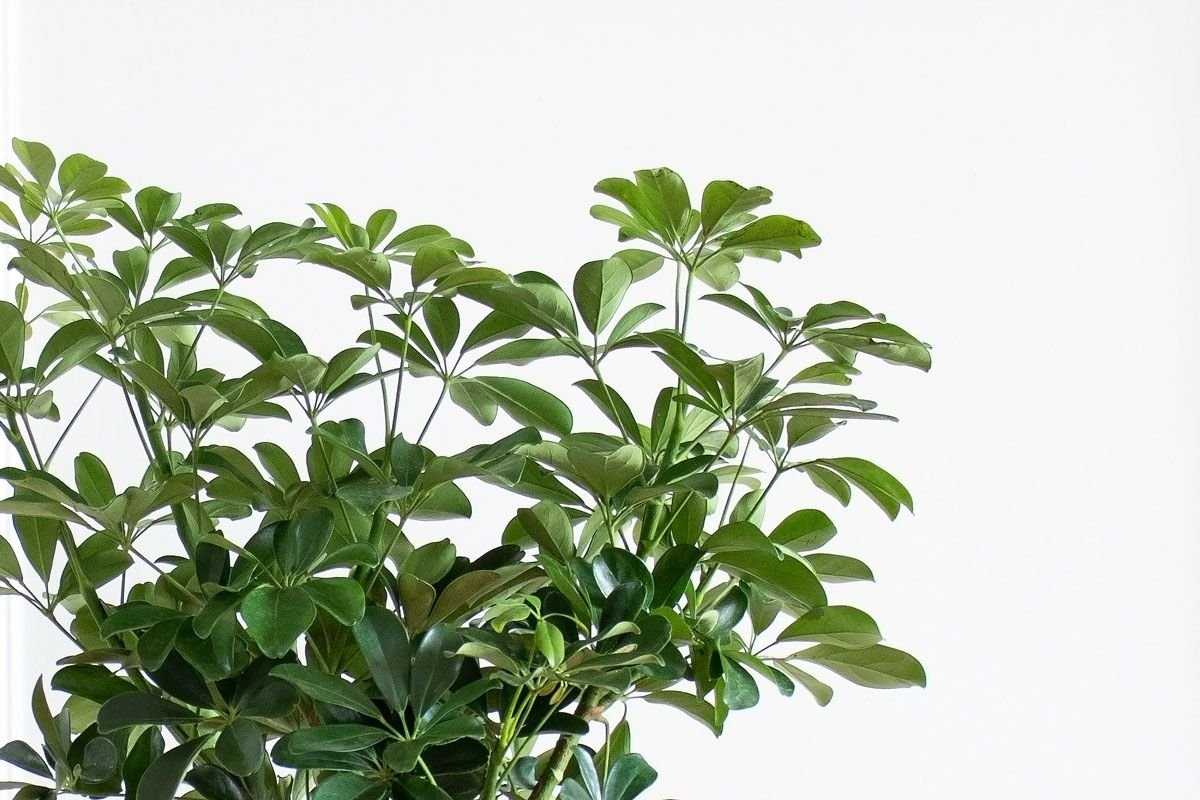
Step 1: Gather the Necessary Materials
Before you start propagating schefflera, make sure you have the following materials:
- A healthy schefflera plant
- Sharp gardening shears or a knife
- Rooting hormone (optional)
- Potting mix
- Pots or containers
- Clear plastic bags or plastic wrap
- Watering can or spray bottle
Step 2: Choose the Method of Propagation
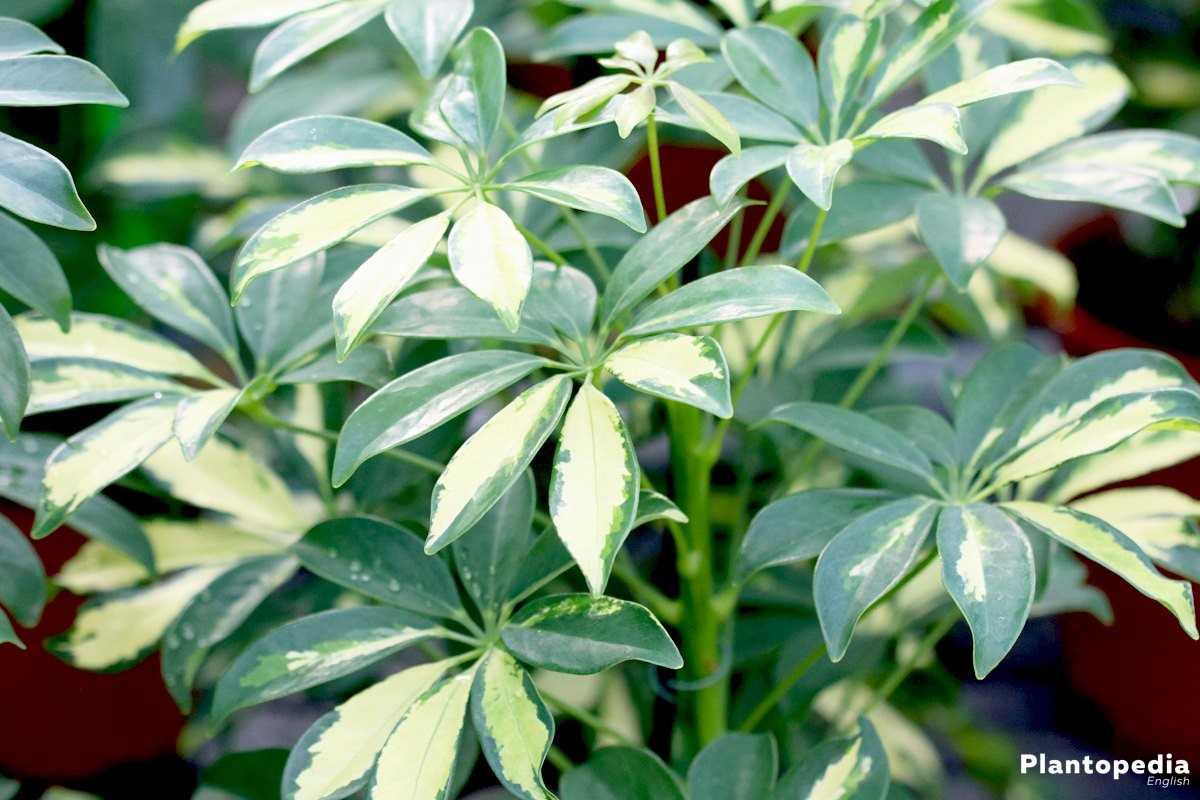
There are several methods you can use to propagate schefflera:
- Stem cuttings: This is the most common and easiest method. It involves taking a stem cutting from the parent plant and growing it into a new plant.
- Air layering: This method is more advanced and requires some skill. It involves creating a small root ball on a stem while it is still attached to the parent plant, then detaching it and planting it as a new plant.
- Division: This method involves separating the root ball of an existing plant into multiple plants. It works best with larger, more mature schefflera plants.
Step 3: Take Stem Cuttings
If you choose to propagate schefflera using stem cuttings, follow these steps:
- Using sharp gardening shears or a knife, take a stem cutting that is about 4-6 inches long. Make sure the cutting has at least one node (a small bump on the stem where leaves or branches grow).
- If desired, dip the cut end of the stem cutting into rooting hormone to encourage root growth.
- Fill a pot or container with potting mix and moisten it slightly.
- Stick the cut end of the stem cutting into the potting mix, making sure the node is below the soil surface.
- Place the pot or container in a warm, brightly lit area, but out of direct sunlight.
- Keep the soil moist, but not waterlogged, by lightly watering or misting it as needed.
- Cover the pot or container with a clear plastic bag or plastic wrap to create a humid environment. This will help prevent moisture loss and encourage root growth. Leave a small opening for air circulation.
- Monitor the cutting regularly for signs of root growth, such as new leaf growth or increased resistance when gently tugged.
- Once roots have developed, usually within 4-6 weeks, remove the plastic covering and treat the cutting as a mature schefflera plant.
Step 4: Care for the New Plants
Once your schefflera cuttings have rooted and are established, it’s important to provide proper care:
- Place the new plants in a bright location, but out of direct sunlight.
- Water the plants when the top inch of soil feels dry, but avoid overwatering.
- Fertilize the plants with a balanced houseplant fertilizer every 4-6 weeks, following the instructions on the package.
- Monitor the plants for any signs of pests or diseases, and take appropriate action if necessary.
- Repot the plants into larger containers as they grow, using a well-draining potting mix.
Step 5: Enjoy Your Propagated Schefflera Plants

With proper care, your propagated schefflera plants should grow into healthy, mature plants. Enjoy their lush foliage and unique beauty!
Common Pests and Diseases that Affect Schefflera Plants
Schefflera plants are generally easy to care for, but they can still be susceptible to certain pests and diseases. Being aware of these common issues can help you take preventive measures and ensure the health of your schefflera plant.
Pests
- Spider mites: These tiny pests can suck on the sap of your schefflera plant, causing yellow spots and leaves to drop. Regularly inspect the undersides of leaves for spider mite presence and treat with insecticidal soap or neem oil.
- Aphids: Aphids can also feed on the sap of schefflera plants, causing leaves to curl and distort. Use insecticidal soap or neem oil to control aphid populations.
- Scale insects: Scale insects can appear as small bumps or scales on the stems and leaves of schefflera plants. They feed on plant sap and can cause yellowing and wilting. Remove scale insects manually or use an appropriate insecticidal spray.
- Mealybugs: These small, white insects can appear as clusters on plant stems and leaves. They feed on plant sap and can cause yellowing and leaf drop. Use insecticidal soap or neem oil to control mealybug infestations.
Diseases
- Root rot: Overwatering or poor drainage can lead to root rot in schefflera plants. Symptoms include yellowing leaves, wilting, and a foul odor. To prevent root rot, make sure the plant is situated in well-draining soil and allow the top inch of soil to dry out before watering again.
- Leaf spot: Leaf spot diseases can cause brown or black spots to appear on the leaves of schefflera plants. This can be caused by fungal or bacterial infections. Remove affected leaves and provide good air circulation to prevent the spread of the disease.
- Powdery mildew: Powdery mildew appears as a white, powdery substance on the leaves of schefflera plants. It is caused by fungal infections and can hinder the plant’s growth. Improve air circulation and reduce humidity to prevent powdery mildew.
Regularly inspecting your schefflera plants for pests and diseases, and taking appropriate actions, will help ensure their overall health and longevity.
Indoor vs Outdoor: Best Growing Conditions for Schefflera
Schefflera plants can be grown both indoors and outdoors, but their growing conditions can vary depending on where they are planted. Here are the best growing conditions for schefflera plants in each setting:
Indoor Growing Conditions
- Light: Schefflera plants prefer bright, indirect light when grown indoors. Place them near a window with filtered sunlight or use artificial grow lights if natural light is limited.
- Temperature: Ideal indoor temperatures for schefflera plants range from 60 to 75 degrees Fahrenheit (15 to 24 degrees Celsius). They can tolerate slightly lower temperatures, but avoid placing them near drafty windows or doors.
- Humidity: Schefflera plants prefer moderate to high humidity levels. You can increase humidity by placing a tray with water near the plant or using a humidifier.
- Watering: Water schefflera plants thoroughly when the top inch of soil feels dry. Avoid overwatering as it can lead to root rot.
- Fertilizer: Use a balanced liquid fertilizer diluted to half strength every two to four weeks during the growing season (spring and summer).
Outdoor Growing Conditions
- Light: Outdoor schefflera plants thrive in bright, indirect sunlight or partial shade. Avoid placing them in direct sunlight, especially during hot afternoon hours.
- Temperature: Schefflera plants can tolerate a wider temperature range outdoors, but they prefer temperatures between 65 and 85 degrees Fahrenheit (18 to 29 degrees Celsius).
- Soil: Well-draining soil is essential for outdoor schefflera plants. Amend heavy clay soil with organic matter to improve drainage.
- Watering: Water outdoor schefflera plants deeply and allow the soil to dry between waterings. Reduce watering frequency in cooler months.
- Fertilizer: Apply a slow-release granular fertilizer formulated for outdoor plants in spring and mid-summer according to package instructions.
By providing the proper growing conditions, both indoor and outdoor schefflera plants can thrive and add beauty to your living space.
Stunning Photos of Schefflera Plants in Different Settings
Take a look at these stunning photos of Schefflera plants in various settings:
1. Schefflera in a Living Room:
This photo showcases a Schefflera plant placed in a corner of a cozy living room. The vibrant green leaves create a refreshing atmosphere and add a touch of nature to the space.
2. Schefflera as a Focal Point in an Office:
Here, a large Schefflera plant is placed near a desk in an office. Its tall stature and lush foliage make it a focal point in the room, creating a visually appealing and calming environment for work.
3. Schefflera in a Dining Area:
In this photo, a smaller Schefflera plant is placed on a side table in a dining area. Its compact and bushy form adds a pop of greenery to the space, complementing the overall decor of the room.
4. Schefflera in a Garden:
This photo showcases a Schefflera plant grown outdoors in a garden. Its lush foliage and sprawling branches create a beautiful and natural look, making it a perfect addition to any garden landscape.
The versatility of Schefflera plants makes them suitable for various settings, whether it’s a home, office, or garden. Their striking appearance and ability to thrive in different conditions make them a popular choice among plant enthusiasts and interior decorators alike.
The Fascinating History and Origins of Schefflera
Schefflera, also known as the umbrella tree, is a popular houseplant that has its origins in the tropical rainforests of Taiwan and Hainan Island in China. The plant belongs to the family Araliaceae and the genus Schefflera, which includes approximately 900 different species.
Discovery and Introduction to Gardening
The first documented discovery of Schefflera was made by a French botanist named Jean-Baptiste Lamarck in the late 18th century. He encountered the plant during his botanical expeditions to Southeast Asia and described it as a tree with large leaves reminiscent of an umbrella. Lamarck collected samples of the plant and brought them back to France, where they were cultivated in botanical gardens.
During the 19th century, Schefflera gained popularity among horticulturists and garden enthusiasts. The plant’s striking foliage and ability to adapt to different environments made it a sought-after choice for indoor and outdoor gardens. It quickly became a symbol of elegance and style, and its popularity continued to grow throughout the years.
Symbolism and Cultural Significance
In addition to its aesthetic appeal, Schefflera also holds cultural significance in many places around the world. In Feng Shui, a Chinese philosophical system that focuses on harmonizing one’s environment, Schefflera is believed to bring good luck and fortune. It is often placed in homes and businesses to promote positive energy and prosperity.
Furthermore, Schefflera has been used in traditional medicine by indigenous cultures in the regions where it is native. The plant’s leaves and roots contain compounds that have been traditionally used to treat various ailments, such as digestive disorders and skin conditions.
Adapting to Different Environments
One of the reasons behind Schefflera’s popularity as a houseplant is its ability to thrive in different environments. It can tolerate a wide range of temperatures and lighting conditions, making it suitable for both sunny and shady spots in a home. Additionally, Schefflera can grow to impressive heights, with some species reaching up to 40 feet (12 meters) in the wild.
Species and Varieties
There are several popular species and varieties of Schefflera that are commonly found in cultivation. The most well-known is Schefflera actinophylla, also known as the Australian umbrella tree or octopus tree, which features long, glossy leaves. Other popular species include Schefflera arboricola, also known as dwarf umbrella tree, and Schefflera elegantissima, known for its variegated foliage.
| Common Name | Scientific Name |
|---|---|
| Australian Umbrella Tree | Schefflera actinophylla |
| Dwarf Umbrella Tree | Schefflera arboricola |
| Variegated Schefflera | Schefflera elegantissima |
Each species and variety of Schefflera has its own unique characteristics, but all share the same beauty and resilience that make them beloved by plant enthusiasts worldwide.
Troubleshooting Common Issues in Schefflera Care
If you’re experiencing any problems with your schefflera plant, here are some common issues and their solutions:
1. Yellowing leaves
Yellow leaves can be a sign of overwatering or underwatering. Check the soil moisture by sticking your finger about an inch into the soil. If it feels dry, it’s time to water. If it feels wet, hold off on watering for a few days.
2. Drooping leaves
Drooping leaves may indicate underwatering or low humidity. Make sure you’re watering your schefflera regularly and providing enough moisture in the air. You can increase humidity by misting the leaves or placing a humidifier nearby.
3. Leaf spots
Leaf spots can be caused by fungal or bacterial infections. Remove any affected leaves and ensure good air circulation around the plant. Avoid getting water on the leaves, as this can promote fungal growth. You can also treat the plant with a fungicide or bactericide if necessary.
4. Root rot
If your schefflera is wilting and the soil feels constantly damp, it may have root rot. This is usually caused by overwatering. Remove the plant from its pot and inspect the roots. Trim any mushy or blackened roots and repot the plant in fresh, well-draining soil.
5. Pest infestation
Scheffleras can be prone to pests like spider mites, mealybugs, and scale insects. Inspect the leaves regularly for signs of infestation, such as webbing or small insects. If you spot any pests, wipe them off with a cotton swab dipped in rubbing alcohol. You can also use insecticidal soap or neem oil to treat the plant.
6. Leaf drop
Leaf drop can happen for various reasons, including environmental changes, overwatering, or nutrient deficiencies. Make sure your schefflera is in a stable environment and receiving proper care. Adjust watering and fertilizing as needed to ensure the plant’s health.
7. Slow growth
If your schefflera is not growing as expected, it may need more light or nutrients. Move the plant to a brighter location or provide supplemental grow lights. You can also fertilize the plant with a balanced houseplant fertilizer according to the package instructions.
8. Wilting
Wilting can be a sign of underwatering, sunburn, or root issues. Check the soil moisture and adjust your watering accordingly. If the plant is receiving too much direct sunlight, move it to a shadier location. Inspect the roots for signs of rot or damage and make appropriate changes to the plant’s care.
By addressing these common issues and providing proper care, you can ensure the health and well-being of your schefflera plant.
Q&A:
What is schefflera?
Schefflera is a genus of flowering plants native to tropical and subtropical regions. They are commonly grown as houseplants.
What are the different species of schefflera?
There are several species of schefflera, including Schefflera actinophylla, Schefflera arboricola, and Schefflera delavayi.
How do I care for schefflera plants?
To care for schefflera plants, you should place them in bright, indirect sunlight and water them regularly. They also benefit from occasional misting and fertilizer application.
What are some common problems with schefflera plants?
Some common problems with schefflera plants include yellowing leaves, overwatering, and pest infestations. It’s important to monitor the plant’s watering and adjust as needed.
Can schefflera be propagated?
Yes, schefflera can be propagated through stem cuttings. Simply take a cutting from the plant, remove the lower leaves, and place it in water or a well-draining soil mix until roots form.
Video:
Umbrella Plant Care | Schefflera Care | Tips N Tricks | Indoor Gardening | Bubbles of Green







